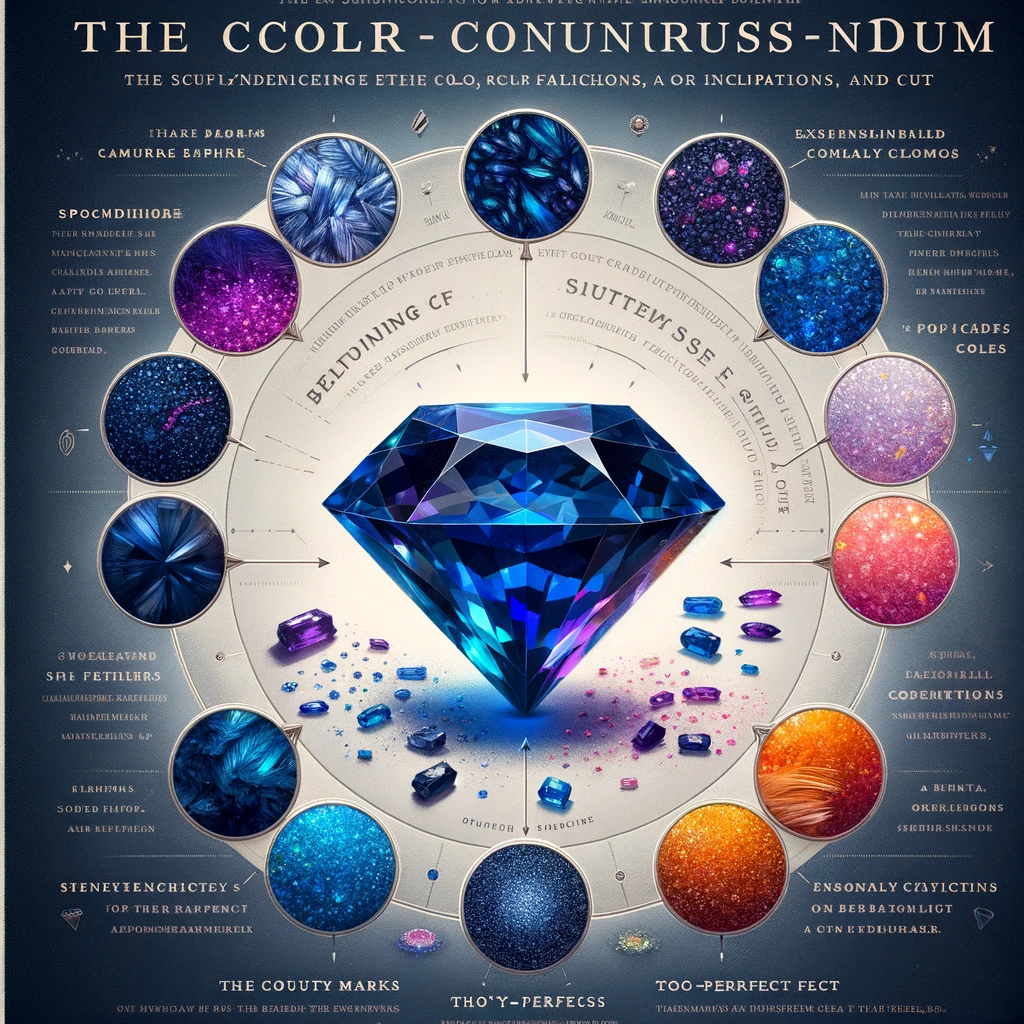How to tell if a sapphire is real
Hey there, fellow gem aficionados and sparkle enthusiasts! Have you ever found yourself lost in a sapphire's deep, enchanting blue, only to suddenly wonder, "Wait a minute, is this treasure authentic or just a convincing masquerade?" Well, you're certainly not alone in this gemstone conundrum. With their luxurious allure and undeniable beauty, Sapphires have been a symbol of the heavens, a guardian of innocence, and a promoter of good health (not to mention a severe fashion statement) for centuries. But here's the real kicker: figuring out whether you've got the genuine article or a clever faux can feel like trying to solve a mystery without the clues.
Fear not, my fearless friends, for we're about to embark on a sparkling expedition to uncover the secrets of sapphire authentication. So, dust off your detective hats and polish those magnifying glasses (or bring your natural curiosity) because we're about to dive deep into the world of natural versus faux sapphires. By the end of this gem of a journey, you'll be equipped with the knowledge to distinguish a natural sapphire from a wannabe with the confidence of a seasoned gemologist. So, buckle up, buttercup – we're going on a ride through the fascinating realm of sapphires!
Understanding Sapphires
Imagine holding a calm, serene piece of the clear, blue sky. That's a sapphire for you – a gemstone that's not just a feast for the eyes but also a symbol of wisdom, virtue, and good fortune. But before we embark on our quest to distinguish the real gems from the impostors, let's get up close and personal with what sapphires are about.
A Rainbow of Possibilities
When most people hear "sapphire," their minds immediately jump to that iconic, deep blue. But hold onto your hats because sapphires are the chameleons of the gem world. These beauties come in a dazzling array of colors – from the deepest blues to vibrant pinks, sunny yellows, and even pristine whites. The only color you won't find a sapphire flaunting? Red, because then, my friends, you've crossed over into ruby territory.

The Tale of Three Sapphires: Natural, Synthetic, and Imitation
Now, let's talk about the types of sapphires out there. First up, we have the natural sapphires, the real deal, born from the fiery depths of the earth, each with its unique story told through inclusions and hues. These gems have seen the world change over millions of years, and wearing one is like carrying a piece of history.
Then we have the synthetic sapphires, created by humans in labs who were so mesmerized by the beauty of natural sapphires that they decided, "Hey, let's make our own!" These lab-grown wonders share the same chemical and physical properties as their natural counterparts but lack the unique inclusions and quirks that give natural stones their character.
Lastly, the imitation sapphires enter the stage, dressed in all their finery, trying to pass off as genuine. These are often made from materials like glass or cubic zirconia, mimicking the look but not genuine sapphires' properties. Think of them as the tribute band to your favorite rock group – similar vibes, but you know it's not real.
Why All the Fuss?
You might wonder, "Why does it even matter?" Well, whether you're a collector, a jewelry enthusiast, or someone looking to make a meaningful investment, knowing your gem's authenticity can make a world of difference- not just in terms of value but also in the story you're wearing or gifting. A real sapphire doesn't just sparkle; it whispers tales of the earth's wonder, luxury, and timelessness.
Visual Inspection: A Gemstone's First Impression
The Color Conundrum
First up on our detective checklist is color, the sapphire's signature trait. Authentic sapphires boast a depth of color that's like peering into the ocean from atop a cliff – deep, mesmerizing, and with layers of complexity. But here's where things get interesting: genuine sapphires often display a phenomenon known as pleochroism, showing different colors or intensities from various angles. So, if your gem seems to have a bit of a personality disorder, changing hues with every tilt, you might be onto something real.

Inclusions: The Beauty Marks of the Gem World
Moving on, let's talk about clarity and inclusions. While the word 'inclusion' might sound like a party crasher, these tiny imperfections are like birthmarks, making each gem uniquely beautiful in the world of sapphires. Natural sapphires often have these inclusions, visible as specks, feathers, or even minuscule crystal formations. If your sapphire is as clear as glass, alarm bells should ring – it might be synthetic or, dare we say, an imposter. But remember, some inclusions are only visible under magnification, so don't write off your gemstone just because it looks flawless to the naked eye.
The Cut: More Than Just Surface Deep
Lastly, a sapphire's cut can tell you a lot about its authenticity. Artisans cut natural sapphires to maximize color and brilliance, often creating unique, asymmetrical designs. If your sapphire is too perfect, with uniform facets that reflect light like a disco ball, it could be a sign of a synthetic creation. True beauty, after all, lies in the imperfections.
Physical Tests: Getting Hands-On with Science
The Breath Test: Hot Air or a Cool Trick?
Here's a fun party trick that's also a neat science experiment. Hold the sapphire up to your mouth and give it a good fog with your breath. If the mist clears up almost instantly, you're likely dealing with a natural sapphire. Why? Because sapphires have excellent thermal conductivity, meaning they disperse heat quickly. If the fog lingers like an awkward guest, you should question its authenticity.
The Scratch Test: Proceed with Caution
Sapphires are tough cookies, ranking a solid nine on the Mohs hardness scale. This means they can scratch almost anything and remain unscathed. If you're feeling daring, you can test your gem by trying to scratch a piece of glass. If it leaves a mark, your sapphire's hardness is legit. But a word to the wise: this test can be risky and damage your gem or the surface you're testing on, so it is best to leave this to the professionals.
Professional Techniques: The Gemologist's Arsenal
Regarding the final say on a sapphire's authenticity, the pros have a few tricks that go beyond the naked eye. Let's peek into their toolbox:
Loupe Look-see: A jeweler's loupe is a magnifying tool that reveals what's hidden from the naked eye. Gemologists use it to spot inclusions, check for synthetic markers, and marvel at the natural beauty of sapphires. If you ever get the chance, ask to see your gem through a loupe. It's like entering a whole new world!
Spectroscope Spectacles: This isn't your average light show. A spectroscope can analyze the light passing through a gem, displaying its spectrum. Natural sapphires show specific absorption lines due to their iron and titanium content. In contrast, synthetics might miss these tell-tale signs, revealing their true nature.
Refractive Index Revelations: Every gemstone bends light in its unique way, measured by the refractive index. Special instruments can gauge this, helping distinguish between natural sapphires, their synthetic twins, and complete fakes. It's like each gem has its secret handshake with light!
Advanced Technological Methods: Beyond the Eyeball Test
Laboratory Certification: Nothing beats a certificate from a reputable gemological laboratory for the ultimate peace of mind. These certificates provide an unbiased report on your gem's characteristics, origins, and, most importantly, authenticity. If you're making a significant investment, ask for this golden ticket.
UV Light Secrets: Some natural sapphires exhibit fluorescence under ultraviolet light, glowing in the dark like a cosmic disco. This feature can vary significantly among sapphires and, while not a definitive test, can offer clues to a gem's origins and treatment history.

Practical Tips for Buyers: Smart Sapphire Shopping
Reputable Sellers Only: Stick with jewelers and dealers with a solid reputation and can provide detailed information about their gems, including origin, treatment, and return policies. A trustworthy seller is your first line of defense against fakes.
Demand Documentation: When in doubt, ask for documentation. A reputable seller should provide a certificate of authenticity or a gemological report. These documents are not just paper; they assure you you're getting what you pay for.
See and Compare: If possible, compare multiple sapphires side by side. This can give you a better feel for quality differences and what a genuine sapphire should look like. Plus, it's a great excuse to look at more sparkly things!
Conclusion: The Gem of Knowledge
Congratulations, you've reached the end of our sapphire saga, equipped with the knowledge to navigate the dazzling world of these gems. Remember, whether you're a collector, a gift giver, or just someone who appreciates the finer things in life, the real value of a sapphire goes beyond its price tag. It's about the stories, the history, and the joy it brings.
So, the next time you find yourself mesmerized by a sapphire's deep blue gaze, remember our journey together. You're not just looking at a gem; you're beholding a piece of the earth's artistry, a symbol of wisdom, and a testament to human ingenuity.
Happy gem hunting, and may your sapphire adventures be as rich and colorful as the stones themselves!
